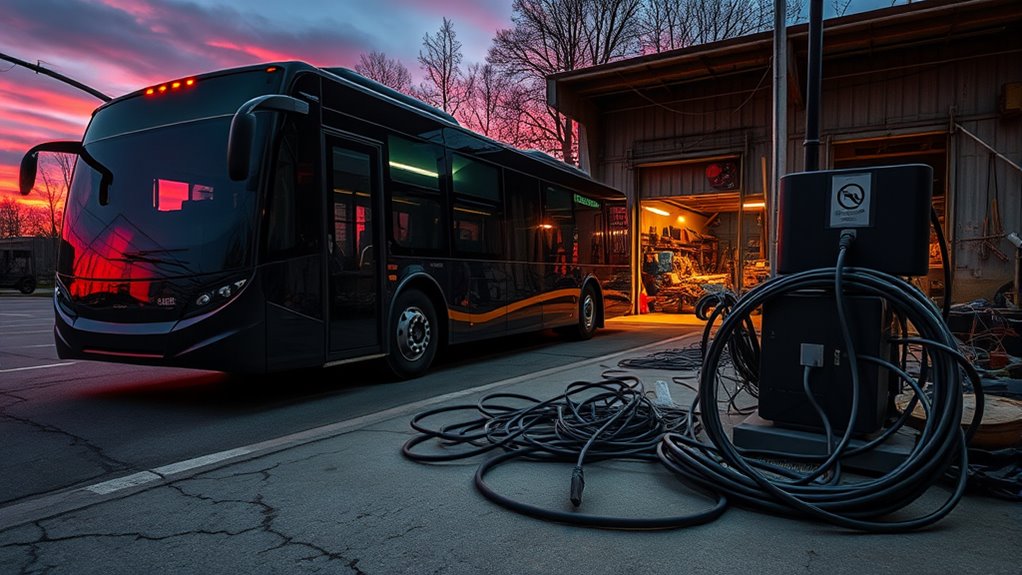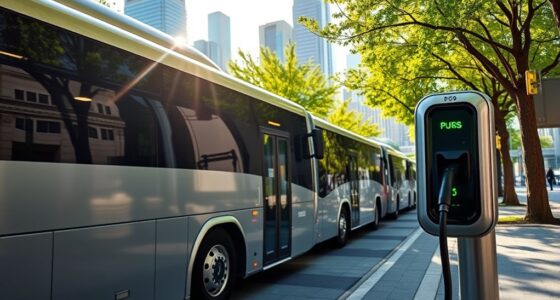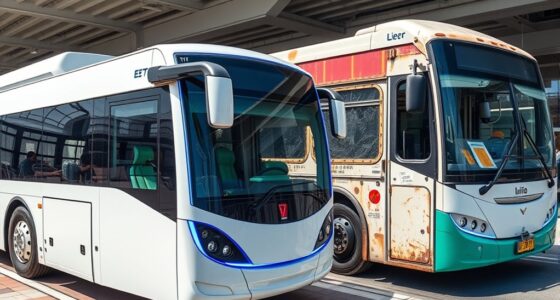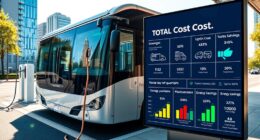Operating electric buses may seem straightforward, but hidden costs can catch you off guard. High upfront vehicle and refurbishment expenses, along with infrastructure upgrades, can strain your budget. Expect fluctuating electricity rates, demand charges, and delays from complex permitting processes. Maintenance costs shift from engine repairs to batteries, which degrade and require costly replacements. Additionally, longer charging times and heavier batteries impact schedules and capacity. To fully understand these hidden expenses and how they affect your operation, keep exploring.
Key Takeaways
- High upfront costs for vehicle purchase and refurbishment often require subsidies and can still exceed diesel expenses.
- Infrastructure upgrades, including electrical grid modifications and permits, add significant capital and delay project timelines.
- Fluctuating electricity prices and demand charges increase operational costs, reducing anticipated savings.
- Battery degradation and heavier batteries lead to costly replacements and reduced passenger capacity.
- Specialized technician training and delayed infrastructure implementation elevate maintenance and operational expenses.

While electric buses offer environmental benefits and long-term savings, their switch from traditional diesel models involves significant hidden costs that often go unnoticed. One of the most substantial upfront expenses is replacing your existing fleet with electric buses, which can cost between 1.5 and 5 times more than diesel equivalents, depending on the vehicle class. For example, repowering a bus with an electric drivetrain might cost around $175,000, although subsidies like the $125,000 vouchers in New York can help offset this.
Beyond the vehicle itself, you’ll need to budget for refurbishment—around $10,000 per bus for cosmetic upgrades and repairs, which may increase if you outsource the work. Additionally, installing charging infrastructure isn’t just about plugging in; it involves building modifications, load redistribution, or even constructing new facilities, all of which add to your capital outlay. Infrastructure upgrades are often necessary to support the increased electrical demand and ensure safety compliance. These upgrades can also involve complex permitting processes that may delay project timelines.
Demand charges for electricity can surprise you. High peak usage can trigger steep “time of use” fees, drastically increasing operational costs. In extreme cases, these demand charges may wipe out the per-mile savings you expected versus diesel. Managing these costs requires real-time load monitoring systems to prevent penalties from grid overloads and underestimating infrastructure needs, which could lead to costly retrofits later.
Since electricity prices are unpredictable and vary with regional generation mixes and fuel markets, budgeting for energy becomes less stable than traditional diesel fuel costs. You might also need to negotiate utility partnerships for better rates, adding administrative complexity. Furthermore, fluctuating energy costs can make long-term budgeting more challenging and unpredictable.
Maintenance costs for electric buses differ from diesel. Routine engine and transmission repairs decrease, but heavier batteries increase tire wear, partially offsetting savings. Batteries degrade over time, and replacement costs are often overlooked in initial total cost of ownership models. Plus, your technicians will need specialized training in EV systems, which can raise labor expenses. Regular battery health assessments and management are critical to ensure optimal performance and lifespan.
Fewer standardized repair protocols mean potential downtime risks, making the fleet less resilient to breakdowns. Infrastructure investments extend beyond chargers. Upgrading your electrical grid—such as substation modifications or transformer replacements—is common, and permitting delays can extend project timelines and escalate costs. These logistical challenges highlight the importance of thorough planning before implementation.
Installing backup chargers or generators provides reliability but adds to capital expenses. In dense urban areas, acquiring land for charging depots might be necessary, and weatherproofing the infrastructure—especially for extreme climates—requires additional investment in thermal management systems. Proper site selection and design are essential to avoid future operational bottlenecks.
Operational efficiency also suffers from the unique demands of electric buses. You’ll need to optimize routes around battery range, which limits flexibility. Longer charging times compared to diesel fuel impact scheduling, and heavier batteries can reduce passenger or cargo capacity. This may necessitate more buses or revised schedules to meet service levels.
Drivers need training on new protocols like regenerative braking and energy conservation, while fleet management software for charge scheduling adds further costs. Additionally, the variability in energy prices can significantly impact your operating budget, emphasizing the importance of comprehensive planning. Reliance on the energy market exposes you to price volatility, which can be mitigated with sustainable energy solutions such as solar-powered charging stations that help stabilize costs and promote greener operations. These hidden costs can significantly impact your long-term budget and operational planning, making the switch to electric buses more complex than it initially appears.
Frequently Asked Questions
How Do Maintenance Costs Compare With Diesel Buses?
You’ll find that electric buses generally cost less to maintain than diesel ones. They don’t need oil changes, filters, or coolant replacements, and regenerative braking reduces brake wear.
However, battery maintenance and specialized diagnostics can add costs. Overall, electric buses save you money over their lifespan—about $100,000—thanks to lower fuel and maintenance expenses, especially when grants or subsidies offset initial purchase costs.
What Are the Long-Term Battery Replacement Expenses?
When considering long-term battery replacement expenses, you face costs around $30,000 per battery. Replacements are needed every 6 to 10 years depending on usage.
You’ll need to plan for these costs, monitor battery health, and explore service agreements or warranties to reduce expenses.
You should also factor in environmental impacts, technological advances, and strategic partnerships, all working together to manage and minimize your future battery replacement costs effectively.
How Does Grid Access Impact Operational Costs?
You need to contemplate how grid access impacts your operational costs. Installing charging infrastructure involves high upfront investments and potential grid upgrades, which can be costly. Demand charges and energy bills also add to expenses.
To manage these costs, you can leverage government incentives, adopt smart charging systems, and plan charger placement strategically. By optimizing your charging schedules and infrastructure, you reduce peak demand and ongoing expenses, making your operations more cost-effective.
Are There Hidden Costs in Charging Infrastructure Installation?
When you consider installing charging infrastructure, you mightn’t see all the costs upfront. Hidden expenses include wiring, permits, and site preparation, which vary based on your location.
Equipment complexity and scalability also add to costs, along with labor and material expenses. These factors can considerably increase your initial investment, so it’s essential to plan carefully and budget for these unexpected or overlooked charges.
How Do Electric Buses Affect Overall Fleet Management Budgets?
You need to contemplate how electric buses impact your fleet management budget. While they offer lower fuel and maintenance costs, the initial purchase price and infrastructure upgrades can strain your finances upfront.
Additionally, managing charging schedules, potential route limitations, and workforce retraining add ongoing expenses. Weather effects and peak demand charges also influence costs.
Balancing these factors helps you understand the true long-term financial picture of operating electric buses.
Conclusion
While electric buses seem cheaper over time, remember that maintenance costs can skyrocket by up to 40% once batteries age. You might think you’re saving money, but hidden expenses like specialized charging infrastructure and battery replacements add up quickly. If you’re considering switching, weigh these hidden costs carefully. After all, studies show that batteries can lose 20% of their capacity after just five years, so plan ahead to avoid surprise expenses down the road.









